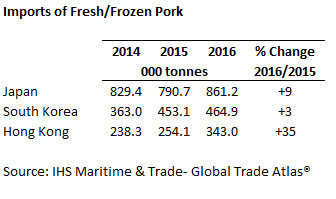



Growth in Other Asian Markets Lags Behind China
ASIA - With the exception of China, other key Asian pork importers experienced relatively modest growth during 2016. Nonetheless, with Chinese demand ultimately expected to fall back, Hong Kong, Japan and South Korea may be increasingly viewed as important outlets for global pork supplies in the coming years, according to Bethan Wilkins, AHDB Pork Analyst.Hong Kong imports were up 35 per cent on year earlier levels during 2016, almost reaching 343,000 tonnes. While from a small base, Hong Kong data suggests the UK had some success supplying them with pork during 2016. Volumes received from the UK reportedly doubled on the year, exceeding 4,000 tonnes.
Part of this overall growth was likely linked to the tight domestic supplies and strong import demand in China, as Hong Kong is a key re-exporter of products to the Asian region. Equally, domestic production in Hong Kong has been limited by the Chinese situation, as fewer live imports have been received. Nonetheless, Hong Kong is also an important pork consumer in its own right and industry sources have forecast total domestic consumption to increase during 2017.

South Korea showed a modest 3 per cent year-on-year growth in pork imports last year, almost reaching 465,000 tonnes. This was largely driven by the latter quarter, as monthly imports were actually back on the year for much of 2016. Expanding domestic production likely dampened the overall demand for imports, a trend which could continue to put pressure on import demand in 2017. Despite these challenges, the UK did expand shipments of pork to South Korea during 2016. While not a major player on this market, the UK sent over 1,000 tonnes more pork to this destination than in 2015.
For Japan, pork imports saw moderate 9 per cent growth on the year, reaching 861,000 tonnes. Frozen volumes from the EU were up 16 per cent on 2015, with growth particularly strong when prices were low early in the year. This was reportedly attributable to Japanese processors replenishing stock while prices were competitive. As a result, import growth slowed in the subsequent months.
The US and Canada also saw Japanese shipments increase on the year, by 2 per cent and 8 per cent respectively. In contrast to EU product, most of this pork was fresh/chilled. During 2017, competitive prices are likely to keep demand for American pork strong, particularly in light of the declining Japanese sow herd. However, higher prices in the EU might dampen imports from this region, particularly as demand for the processed products produced from imported frozen pork is reported to be weak.








